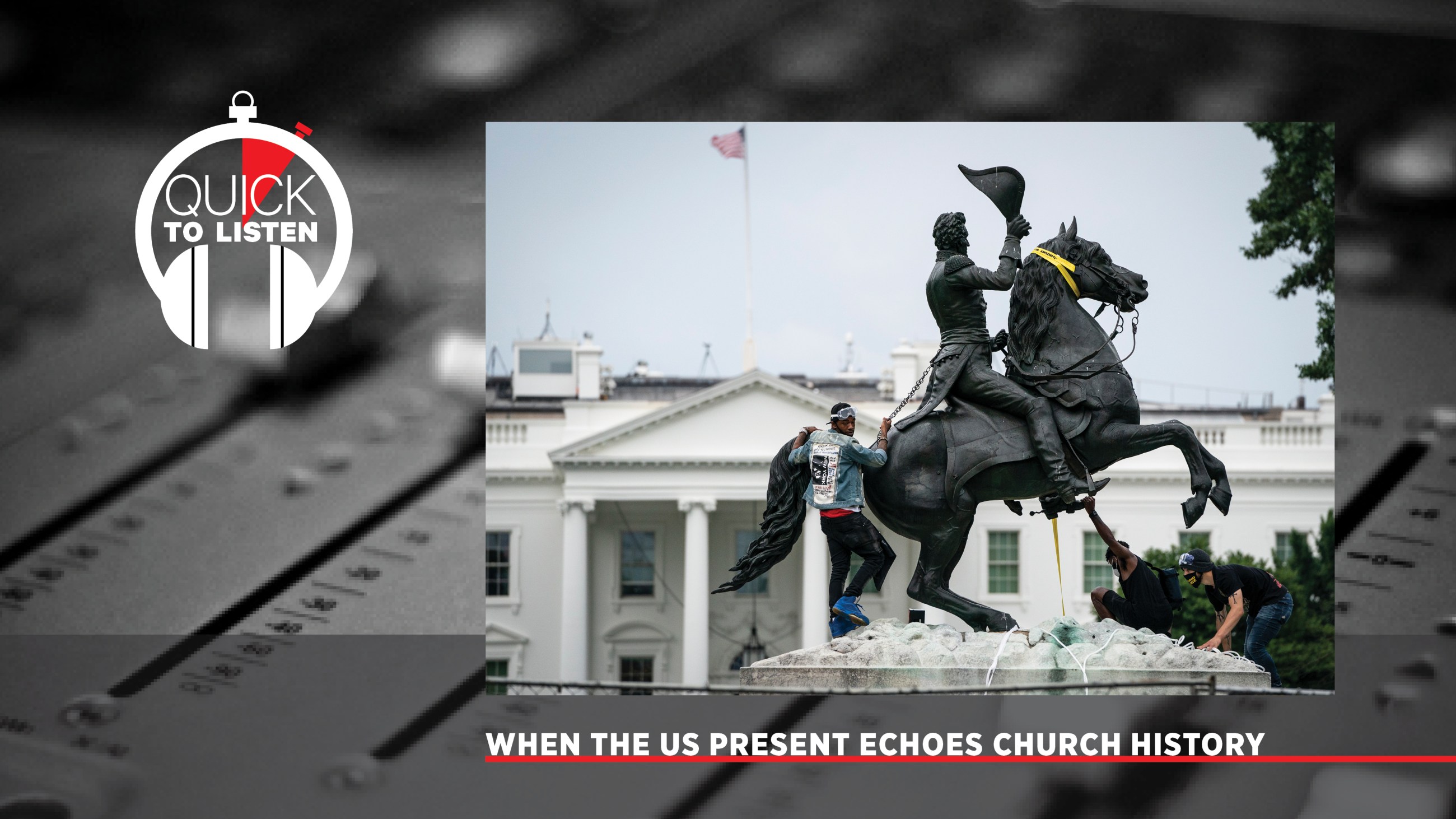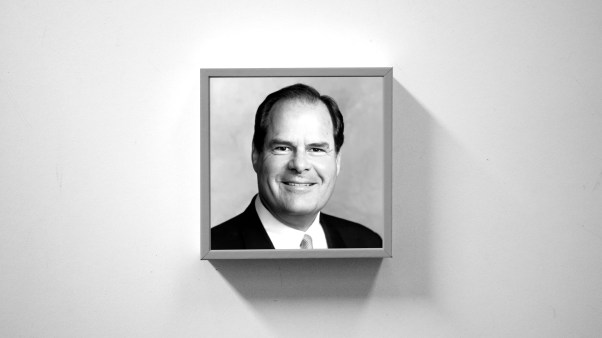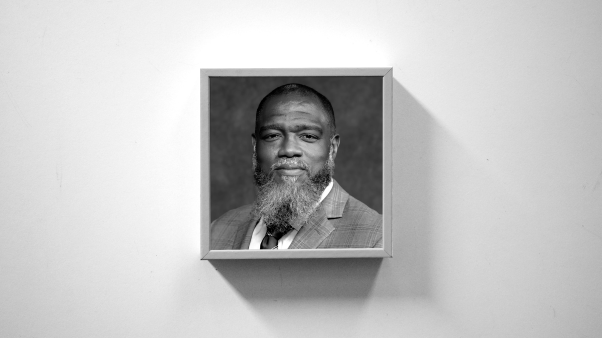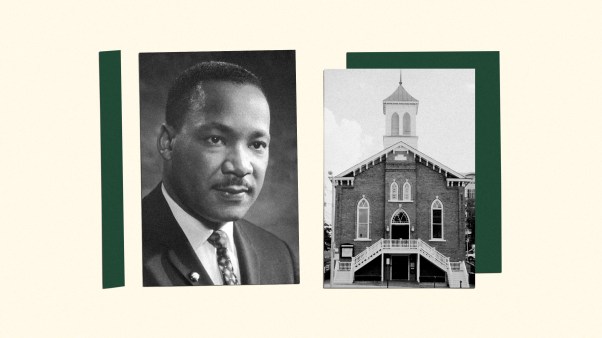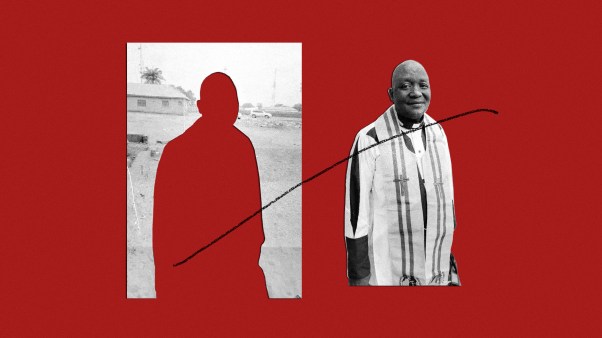The protests that followed the killing of George Floyd in May started with a focus on police brutality. But six weeks later, a dominant theme is the removal of monuments, and memorials. Protesters have torn down or vandalized dozens of statues connected to the Confederacy and to other controversial historical figures like Christopher Columbus.
But this isn’t the first time that statues have been torn down en mass amid widespread protests. After Constantine allowed Christianity in the Roman Empire, Christians tore down so many statues that in Athens they reportedly became known as “the people who move that which should not be moved.” Early church battled each other over religious iconography. Reformation Christians inspired another round of eager statue smashing and removal.
“What's funny is when I was first getting acclimated to art as a Protestant, and learning that art history mattered, we were embarrassed about our iconoclastic heritage,” said Matthew Milliner, associate professor of art history at Wheaton College. “But what an honor to be known as ‘the people who moved that which should not be moved.’”
Milliner joined global media manager Morgan Lee and editorial director Ted Olsen to discuss how much earlier Christian battles over statues echo today’s fights, what Christians have learned that might help us better understand the call to remove statues today, and whether we should even be creating memorials and monuments in the first place.
Take Quick to Listen’s survey!
What is Quick to Listen? Read more
Rate Quick to Listen on Apple Podcasts
Follow the podcast on Twitter
Follow our hosts on Twitter: Morgan Lee and Ted Olsen
Follow our guest on Twitter: Matthew Milliner
Music by Sweeps
Quick to Listen is produced by Morgan Lee and Matt Linder
The transcript is edited by Bunmi Ishola
Highlights of Quick to Listen: Episode #220
Let's start with a bit of art history. In the intro, we referenced how after Constantine made Christianity the religion of the Roman Empire, early Christians tore down and destroyed many pagan images. Is that accurate or was it a more limited action focused on specific images or places?
Matthew Milliner: If it's inaccurate, there are a lot of brilliant forgeries out there that have successfully transported back in time and carved crosses on the statues of the head of Aphrodite.
It is accurate. This was done. You go to Egypt and you'll just see a cross carved into this beautiful hieroglyph. In some senses, this breaking of images is the birthright of Christians, the “people who moved that which should not be moved” was the way Christians are described.
What's funny is when I was first getting acclimated to art as a Protestant, and learning that art history mattered, we were embarrassed about our iconoclastic heritage. But what an honor to be known as the people who moved that which should not be moved—the ministers who gathered together as Silent Sam goes down and are singing as an idol is removed.
That is an element not just of the Protestant tradition, it is the universal DNA of what it means to be a Christian. It is an image breaking thing to be baptized in the name of the Father, Son, and Holy Spirit. Your ego is getting across carved into his forehead. And your idol of yourself is being drowned with Jesus. And so in some senses, there's nothing surprising about it.
This has happened many times before. and Christianity has a part to play in it. Iconoclasm is the foundation of Christianity as it is. It just lays it out in the New Testament.
Were most of these statues of gods and goddesses and, or of Caesar? Or were there statutes of just rich and influential citizens that were also torn down or destroyed?
Matthew Milliner: Well, it's not that every single statue in the ancient world was taken down. And that's what's so fascinating. Sometimes they were repurposed or used in a different way. Some were renamed. For example, we're going to take this statue of Aphrodite and maybe be inspired by it as we move down the centuries, assimilating that understanding instead of the need to utterly destroy it.
People love when they write their catalogs to make fun of Christians for doing this, but now that's not so cool because that's what we want to do. We realize the impulse to destroy an image is a part of justice. But to stop at the iconoclasm impulse would be inadequate. I think Christianity itself had to realize, we need to move past that icon breaking stage and move into the recreation, assimilation, and creative responses, not just destructive responses to the idols that are around us.
Could you give us a sense of how hard these statues were to make, what it meant to make them, and whether it was hard to tear them down?
Matthew Milliner: Well, it's as difficult to tear them down as it was a week ago to try and tear down of the equestrian statue of Andrew Jackson in front of the White House.
The technology of creating those kinds of imperial portraits required resources. And the early Christians did not have the resources to produce those statues nor did they want to—and not only did they not have the money because Christianity was a persecuted minority at first. Even when they had the money that style was changing because to create something that's too imminent was seen as idolatrous because of course Christiania inherits the DNA of Judaism and there's this suspicion about what images can do.
But bronze casting isn’t easy, but The Dark Ages were glittering with mosaics. The reason they're not pursuing that technology of political imminence is because the gold mosaics are pointing to the other world, getting you into heaven, and giving you an idea of a world that is saturated with God and moves you beyond the world to God. That's the early Christian cosmos. And so they are not interested in that kind of statuary. But then in the Renaissance, when they redevelop that, it's immediately used to glorify political rulers and we're in the same situation again.
And when we're looking at the 19th century, early 20th century statues that are being taken down right now, when they were built it was America trying to flex its aesthetic muscle to say, “Look, we can keep up with the standards of Europe and we can make beautiful, big statues like they did in the Renaissance.”
And if we're taking those down, we're in some senses in accord with some early Christian principles. Or not. You have to be principled in the decisions that you're making. And I think you see an evolution and development of sophisticated thought about art that happens in Christianity, but we don't know how to think in a sophisticated way about art. So of course our only response to it is to get rid of it.
But if we inherit these lessons, we can move up the schema into a more sophisticated approach to these monuments. The approach of just destroy and deface can be liberating. It's part of what it means to be recreated, you have to destroy the old. But what happens when you move forward? That's the next step in the conversation.
In Christian history, there was this debate about whether icons were okay or not. And during the Reformation, many images and other kinds of devotional objects were removed. The second commandment is often used as a reason to not create images of God, but how did the incarnation of Christ change the ways Christians thought about images?
Matthew Milliner: The Christian Church was no longer the persecuted minority, but they had torn down all the statues, so now they’ve got to make some things of their own. And they just started doing it. And then a couple of centuries later, they begin asking, is there a theological rationale for this? And then a bunch of people says no and so they start to take some down. It did happen to an extent on theological grounds.
It’s a century-long theological debate, but the decision was made that it is indeed permissible to create images of God because He imaged himself first in Christ. It is not a violation of the commandment to not make graven images—that's God saying, “wait, don't make pictures of me. Let me do that myself. Here I am. Jesus.” Now you can depict me.
Christians come to the realization that it is permissible. Now we can have a redemptive image that shows us, reminds us of, what it would have been like to have walked with Christ and with the disciples.
That is never at the cost of the invisibility of God. It shouldn't be, sometimes it becomes that, but that's bad Christian visual theology. The image of Jesus has to be held hand in hand with the undepictability of the Father. If we make that mistake—as the Christian so often have done—we write atheists a ticket for all the misunderstandings that they hold, we've given it to them for free, that we invented that deity.
You have this rhythm of negative destruction of images, positive creation, and then some negative destruction again moving toward positive. And we're feeling those rhythms now in this country.
How does this understanding impact depictions of saints or the human celebrities of the faith?
Matthew Milliner: Once you get Jesus permissible, you've secured Normandy, right? Jesus was the hard one. And so it becomes okay from that point forward to create images of saints and others. You just can't worship them.
And they never said they were. That's the caricature that John Calvin projects onto the past. And in some cases, I think he was on target, but they weren't worshiping them as if they were the saints themselves. There were in a sense, not doors but windows into the present.
We believe those people are with God—to be absent from the bodies to be present with the Lord. If you have a picture of a deceased loved one in your home, you're doing that. And your heart might inflame with love as you look at that image. That's what early Christian images of the saints offered us. And there was a theological council that deemed that to be permissible.
The Reformers looked at images of human saints and felt Christians were giving them too much attention because they are spiritually fallen and broken beings. Do you see a connection between the debate over imaging sinful humans in the church have and the current discussion we’re having about which statues to remove in the US?
Matthew Milliner: That's a very acute question because the choice to remove images didn't mean they went away forever. They just came back in a political form.
You often see naval captains honored in churches in Amsterdam. And you see it in New York too. In great places like St. Paul's, there it is an American political figure has taken over that space, which was intended to be preserved and kept clean. And so we have made our little Caesar images of one kind or another, even if we're honoring them as these great Christian heroes who did their service to their country.
What I would say to anyone listening to this is to audit your visual space. What is being honored? When you walk through Protestant visual culture, you’ll realize there have been some errors made in this regard. And maybe we need to summon up our iconoclastic heritage that is shared with the entire Christian tradition.
That’s what the Orthodox church did in the last 20 years when they cleansed Russia of these images of Stalin and Lenin. And in one case, they even put them into what's colloquially referred to as “Stalin World,” which is this is a park in Lithuania. They just took all of these images that were intended to provoke awe and wonder and fear, and now people can take their little family selfies as they go through these decapitated heads and busts.
And it's one of the most redemptive things imaginable. These images that were responsible for the slaying of so many people have now become jokes. That's the toppling of the idols in our time. So we're living through that again. And maybe that's what some of these missed opportunities with these statues that we're taking down—all kinds of stuff could happen with that Confederate statue—to not let the next generation off the hook.
How are we going to responsibly repurpose these monuments? Or maybe a responsible destruction is necessary in order to move forward as a democracy, instead of just ripping these things to pieces.
Would you say that there's something that makes statues uniquely special or different from a mural or a painting?
Matthew Milliner: The Christian tradition, and the Jewish tradition, has always felt just a little bit differently about three dimensionalities, because it's so real, it's so here.
There's maybe a good reason that that technology was lost for a while because it claims to offer a lot. And it doesn't mean it can't be used redemptively, but that's why it's always important to remember the icon is the brake on visual culture.
If you want to find the brake pad for how to deal with the images that are saturating your life like never before in human history, you get an icon. That will slow you down. Because an icon was deliberate. The icon is this central gift.
It's not beholden to the romantic individualism that has infected the artistic culture now. The thing about the icon is this tradition that seeps through history and it contains all this wisdom. In some senses they're intended to restrain the mental faculties, rather than delight and stimulate the eye, putting you in touch with God who is with us all the time.
And it's an experience that many Protestants are recovering, and there are creative reinventions of that tradition for this day. In our art department classroom, we have the classic Sinai icon of Jesus, and it's this glorious image, but right next to it, we have this image of the Black Christ. I don't think Jesus was African, but I know that he identifies with his body, the African American church, just as he identifies with me as a white person. It's important for me to remember that. So I have this image.
Now, you put that next to the image of a more accurate historical Jewish Jesus, and then you have a rich visual Christology that can guide us through these times.
What type of charge would you have for the church at large—many of whom do not necessarily identify as artists, but have strong and robust opinions about statues and so forth? And what type of charge might you have for Christians who are in the arts community?
Matthew Milliner: First, understand what's going on in contemporary art. That's so important. We are just not in the traditional, statue-making, catch-up-with-Europe culture anymore. And so there are so many fascinating, exciting developments that have occurred. So many exciting things are happening in memorial culture. So understand what's going on there.
And then, stop pointing fingers at the South. If you live in the Midwest, realize we've got some stuff to cover ourselves. Because we're sitting on the land of people who received and embraced the gospel with joy and then were ejected by Andrew Jackson. You will get a perspective of redemption hope and healing in this country, but you don't get that until you deal with the suffering until you deal with what happened.
And there are ways to do that. It's all available to us. It's all there. We just have to hear that. And what we're hearing that we're not going liberal. We're not tilting to the left. No, we're going deeper into the body of Christ because that's Jesus speaking to us through his persecuted people.
And realize it's not unpatriotic. It's the most patriotic thing you could do! We've got to do a whole audit of what our memorials have done in this country and realize that we are in no way safe here in the Midwest, because the wonderful work of repentance is ahead of us, and we believe in grace.

